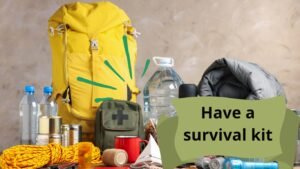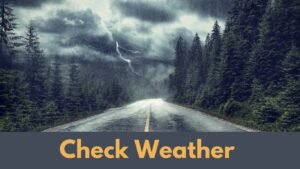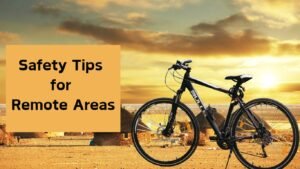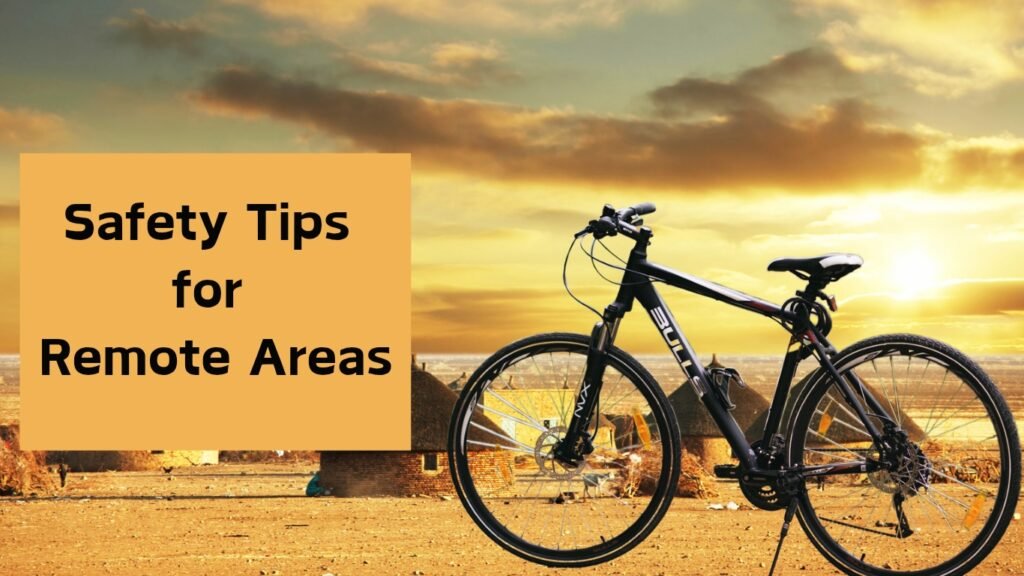Riding a mountain bike in remote areas feels different, as there is not too much noise, not too many people, etc.
However, due to the smaller crowds and isolation from civilization, you want to take additional safety precautions.
In this guide, we will discuss how you can prepare yourself and your bike for riding in remote areas.
This includes facing unexpected wildlife, flat tires, wrong turns, what should you do to prevent yourself from losing, and much more.
Overall! This guide will help you ride confidently and safely.
Also read:
1. Plan Your Route Like Your Life Depends on It (Because It Might)

When you are going mountain biking in a remote area, it would be better if you make a plan for the route you will ride through.
But besides this, you also want to do something different, which many riders do not. Riders often make a path and think they will follow only that.
So here are some extra things you can do for more safety in case you get lost; these things will help you.
- First, you want to download some apps with a map option available, such as TrailForks, Komoot, Google Maps, MTBProject, etc. Plus, you want to download them offline, too, in case you don’t get a signal in a remote area. So, you can use the offline version to get out of there.
- Secondly, you want to note down all spots, especially the major ones like trailheads, water Resources, emergency exit points, etc. So, if you lose the way, you can recognize the path again through these spots.
- Most importantly, when you are going away from home, especially in a remote area, you want to tell any of your family members or a close friend where you are going and how much time it will take to return home. So if you don’t come on time, they will look for you or try to contact you.
Also read: Warm-up exercises you to to before a ride
2. Pack a Survival Kit That Fits in Your Pack

Most bikers think they will come back home without facing any difficulty when they leave home. It’s good to think positively, but you still need to take some safety precautions.
In our case, you want to ride in a remote area, so you will need a survival kit because remote trails have little room for error.
Here is what you can pack in the survival kit:
Navigation Tools:
You want to pack a navigational tool, which can be a GPS device, compass, or even a map.
And if you are downloading Google Maps, make sure you also download their offline version.
Plus, I would also suggest you download some dedicated apps such as TrailForks and MTB projects, as they are specifically designed for mountain bikers.
First Aid kit:
A first aid kit, which can include bandages, antiseptic wipes, and pain relievers, is also important.
Multi-tool:
Don’t forget to carry a multi-tool and tire repair kit, as snipped chain or flat tires are pretty common, and they can leave you stranded.
Extra clothes:
When you are away from home in a remote area, I would recommend you carry lightweight blankets if the temperature drops so you can use them. Here is guide: What to Wear for Mountain Biking.
Water Filtration system
A water filter is also important if you are on a mountain bike backpacking journey.
Steam is a great water source that you can use even without filtration, but you still want to have a filter or purification tablet.
Light source:
Lastly, carry a headlamp or flashlight. If the trail gets black faster after sunset, you can use that light. Plus, there also needs to be a light on your bike for use.
I have mentioned all these things, like the navigational tools, first aid kit, multi-tools, emergency blanket, etc. You want to check them all before you go for the ride.
Plus, you also want to do regular mountain bike maintenance before leaving the home. It can include tightening, nightball, lubing chain, and other things.
Also read: Pre Ride Checklist for mountain bikers (You need to know)
3. Master Basic Bike Repairs Before You Go

Now, I’m not saying that you need to learn everything regarding mountain biking, like how to fix everything, but yes, if you are trying to enjoy riding in remote areas on various trails or going on multi-day trips,
So, I recommend you learn some basic repairs before you head towards the remote areas away from your home.
Here is what basic repair you should learn before a multi-day trip or a trip too far, like in a remote area. (How to Plan a Mountain Bike Trip to Europe)
- You want to learn how to fix a flat tire or replace a tube.
- Secondly, you want to learn how to reattach a slip chain or replace it if it gets broken; although you need to check it at home, chances are high that you won’t face any problem midway. (Learn MTB chain maintenance)
- You also want to learn how to adjust brakes and derailleurs because you can’t imagine riding a bike with brakes that don’t work properly. A small incident can cause a big accident.
- Learn how to repair a bent derailleur hanger.
Remember
If you don’t know some basic MTB repairs, then you might regret it later when you face problems and notice that your bike’s chain is snapped on the climbs midway away from the trailhead.
Without a quick link and chain tool, you have to push your bike for hours to go back, whether on top of the climb or at home.
So, you want to practice these simple things before going on a multi-day trip or to a remote area.
Also read: How to Fly With Your Mountain Bike in An Airplane
4. Check the Weather, Then Check Again

Weather changes quickly, and it waits for none; you will start riding in sunny conditions, and quickly, you will find yourself in a worse or lightning storm.
These things are common, but it’s your duty to prepare yourself to face all kinds of situations that might occur regarding weather,
First of all, I recommend you check the weather forecast before leaving home, let’s say you are going for 1 day or 2 days.
In such case, you will check the weather conditions of today and tomorrow, and based on this, you will plan the ride,
If you see the next day is going to be rainy, you can either avoid riding on that day, or you will carry some layers with you.
Here are some weather safety tips that you may need:
- You want to carry an extra layer of clothing, such as you can have lightweight jackets that are waterproof,
- You want to avoid exposed peaks like lightning loves ridgelines.
- It’s good to monitor wind speed, as high winds are often not good for riders; they make it hard to ride the bike, especially against wind.
Pro tip: if you see the sky turning dark or chances are high, the thunder will come, so you can head downhill fast and avoid any open space or tree, especially the taller one.
I have even seen trees falling in front of my eyes during this storm; it was a really scary moment in my life.
Also read: How to improve strength for mountain biking?
5. Hydrate and Fuel Smartly

Do not go to a remote area without eating proper food and hydrating yourself, especially if you are going on a downhill trail or want to climb.
You need to eat something at least 30 minutes before the ride but do not eat until your stomach fills.
You can just eat around 70% of your stomach fill.
If you eat too much, you will feel lazy, and you may not perform well, or you might even feel vomiting in some cases.
Plus, you need to carry extra water bottles for a longer ride, especially if trails are technical or the weather is sunny.
Here are some hydration rules that you want to follow:
- You want to carry at least a 2-liter water bottle for a short ride, and you can increase the number if you are on a longer ride.
- Plus, you want to bring a hydration pack with a tube for snipping while riding.
- It’s optional, but you can also pack electrolyte tablets to replace lost salt.
Here are some food tips:
- Besides eating something right 30 minutes before the ride, you also want to carry some high-energy snacks like trail mix, granola bars, dried fruit, etc.
- Also, carry a protein bar as a backup option if you need more fuel on the ride.
- You can even carry a sandwich if you are willing to ride for 4-6 hours or even more because it’s normal to burn a lot of calories, especially on climbs.
Also read: How to build Stamina for Mountain Biking
6. Ride with a Group or Use a Tracking App
If you ride a mountain bike in remote areas, it gives you a nice experience as you do not have a lot of people to make noise, and you can enjoy the peaceful environment.
But if something goes wrong, you won’t also have anyone to help you.
However, here are some options for your safety.
- You can ride in a group of mountain bikers. They will help you in an emergency, plus riding in a group will be more fun.
- If you do not have a friend circle of mountain bikers, you can use apps like Garmin InReach and Strava Beacon. These device and apps allow other people to track your location in real time. So if you get lost, other people can find you.
- You can tell your friends or family members about the trip you are going to. If you do not come back at the right time, they will use these apps to find you.
- You can also carry a satellite messenger. Garmin inReach Mini is a good device for tackling this situation. It allows you to send an emergency message even without cell service.
Note: You Need Learn These Mountain Biking Etiquettes to Ride In Group
7. Watch for Wildlife—And Don’t Be the Prey

When you are riding in a remote area or through forest trails, it’s very common to encounter wildlife.
However, you need to learn how to encounter wildlife. Sometimes, you will face deer, which are not usually dangerous as they are not very strong.
But bears are stronger than deer. So, you want to learn what you need to do to save your life from them.
But keep in mind that you need to work calmly and smartly.
Here are some wildlife safety tips that you need to learn before your remote area ride.
- Firstly, you want to make noise. Secondly, you want to talk or attach a bell to your bike and avoid suppressing any animals.
- Secondly, you want to carry bear spray. It’s a lightweight but effective way to keep a large predator, especially like a Bear, away from you.
Store your food securely and avoid leaving snacks where animals can find them. It’s good for you and also good for the forest environment.
Pro-tip: if you see any predator like a Bear, do not run away or panic. You just have to make a sound and pretend as if you are bigger than the bear and stronger than him.
I have even seen people encountering Giraffes while riding. But those riders were So, the giraffe didn’t do anything to them. The giraffe was just curious to touch and smell them but didn’t do anything special.
Also read: 4 Weeks mountain bike training routine
8. Pace Yourself—Fatigue Leads to Mistakes
If you are on a multi-day trip or even a single-day trip, don’t force yourself to ride more and more.
By doing so, you won’t enjoy the riding; instead, you will get too tired and unfocused. And eventually, you might even crash.
So, in your case, you want to avoid this in remote areas, especially if you are riding solo. When you are unfocused or getting fatigued, you cannot ride properly.
Here are some energy-saving tips that you want to consider:
- You want to take a break as often as possible. Whenever you stop, drink a little water, even though if you are not feeling thirsty, you still need to take a sip. And then check a map.
- If you are in a sunny area, after riding for like 30 minutes or 40 minutes, you must take a break and stand for a few minutes in a shady area, like under a tree, to allow your body to recover and continue your ride.
You also want to control your efforts, like you can save bursts of energy for technical climbs and obstacles.
9. Learn Emergency Procedures Before You Need Them

It’s normal to face any problem on a longer ride, especially in adventurous sports like mountain biking.
However, you need to know how to handle a crash, dehydration situation, when you are lost, or when you have twisted your ankle.
If you are prepared for all these things, you can come back home safely without any further help.
Here are some key emergency tips that you need to follow and learn them:
First of all, it doesn’t matter what happens; you want to stay calm. Doesn’t matter whether you face a wild animal like a bear, or you fall from the bike and get a bit injured, or you get lost.
You have to be calm because a calm mind works better.
You can also use a whistle, mirror, or satellite communicator, as we have discussed before, to give a signal for help.
Besides this, you want to apply a first aid kit to stop bleeding if you have got injured before moving further or continuing your journey.
Also read:
Final Thoughts
Riding a mountain bike in remote areas or on forest trails is a nice way to enjoy some peaceful time with nature.
However, you want to take some safety precautions before going on a ride. You want to do regular mountain bike maintenance before the ride.
Then, you want to learn how to fix a broken chain and how to fix a puncture, and overall, you want to prepare yourself for a safe ride from the disaster.
Besides this, don’t forget to carry a first aid kit, hydration pack, some extra snacks, and tools to fix your bike (like CO2 tire inflator kit). Plus, you need to learn some MTB safety tips.
What essential gear should I bring for a remote mountain biking trip?
Some essential mountain bike gear includes a GPS device for navigation as you don’t just solely want to rely on Google Maps.
You can specifically have deducted all for MTB riding like MTBproject or TrailForks on your smartphone.
Plus, you want to have a repair kit that includes a multi-tool, sharp tube, tire levers, chain breaker, patch kit, and a CO2 inflator, especially for multi-day trips or a longer ride.
Furthermore, you want to have a Helmet, first aid kit and some snacks to refuel yourself. And some bandages, antiseptic wipes, band-aid relievers, etc., in case you fall so you can use these things.
Communication devices like a personal locator beacon, also known as PLB, for emergencies in remote areas. And extra clothes like a lightweight jacket and a headlamp or flashlight.
How can I plan for unexpected mechanical issues during a remote mountain bike ride?
You can’t find mechanics to repair your mountain bike everywhere, especially in remote areas.
That’s why you want to learn some things like how to repair common things such as punctures in the tire or tube.
Plus, before every ride, you want to have a pre-ride inspection to make sure your bike is properly okay and that you are carrying all the necessary items, like spare tubes, chain linkers, derailleur hangers, etc.
Besides this, you also want to carry a few lightweight tools like multifunctional tools to save space and weight.
What safety precautions should I take when mountain biking alone in remote areas?
Some common precautions that you can take as a solo mountain bike rider in a remote area is to let other people know where you are going to ride and when you are expected to return home.
After this, you wanna check weather conditions because the weather changes quickly, and you want to avoid any unsuitable weather where you can’t ride.
Plus, you want to be aware of wildlife. There are many areas where you might encounter bears, deer, and other animals. To protect yourself from them, you can carry bear spray.
Moreover, you want to show yourself stronger than any animal you face (Usually a bear or deer), plus remain confident to keep them away from you.
Furthermore, being a solo mountain biker in a remote area, you need to be prepared for an unexpected night out. You can carry some food, water, and warm clothes.
Apart from this, if you’re on a multi-day trip to a remote area, establish regular check-in times with a contact person. It can be your close friend or a family member like your dad or sister.
Lastly, do not forget to carry food and have a GPS tracker that can even help you find a location when networks aren’t available. You can download Google Maps offline.
Also check: What happens if you ride a bike 30 minutes a day

Ali is the founder of Mountain Bike Insider and an passionate rider with years of hands-on experience in mountain biking. From testing gear to exploring trails, Ali writes based on real riding knowledge to help others make smart, safe, and enjoyable biking choices. Every guide is built on research, personal use, and a passion for the sport.







